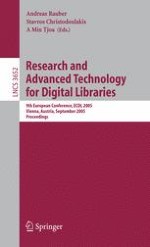Since its inception in 1997,the EuropeanConferenceon Researchand Advanced Technology for Digital Libraries (ECDL) has come a long way, creating a strong interdisciplinarycommunityofresearchersandpractitionersinthe?eldofdigital libraries. We are proud to present the proceedings of ECDL 2005, the ninth conference in this series, which, following Pisa (1997), Heraklion (1998), Paris (1999), Lisbon (2000), Darmstadt (2001), Rome (2002), Trondheim (2003), and Bath (2004), took place on September 18–23, 2005 in Vienna, Austria. ECDL 2005 featured separate calls for paper and poster submissions, resu- ing in 130 full papers and 32 posters being submitted to the conference. All - pers were subject to a thorough peer-review process, with an 87-person-strong Program Committee and a further 68 additional reviewers from 35 countries from basically all continents sharing the tremendous review load, producing - tween three and four detailed reviews per paper. Based on these, as well as on the discussion that took place during a one-week on-line PC discussion phase, 41 papers were ?nally selected for inclusion in the conference program during a 1. 5 day PC meeting, resulting in an acceptance rate of only 32%. Furthermore, 17 paper submissions were accepted for poster presentations with an additional 13 posters being accepted based on a simpli?ed review process of 2–3 reviews per poster from the poster submission track. Both the full papers as well as extended abstracts of the posters presented at ECDL 2005 are provided in these proceedings.
